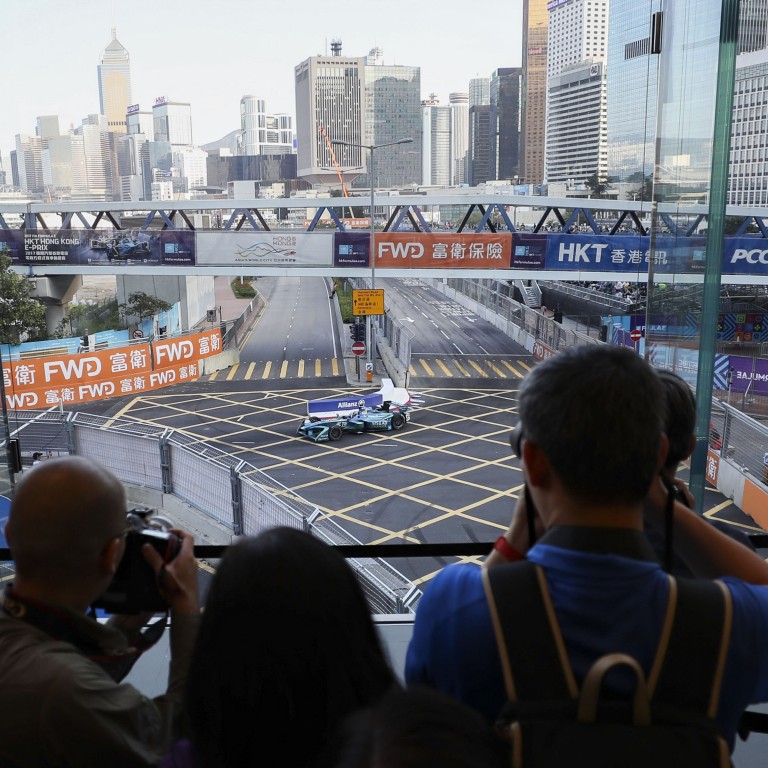
Formula E: Hong Kong E-Prix can solve its street circuit headache with move to Tsim Sha Tsui
- Organisers must extend Central harbourfront circuit next year or find another street track
- Otherwise Asia’s self-proclaimed events capital will lose one of its flagship showpieces
While HKT Hong Kong E-Prix will once again take centre stage on Central Harbourfront this weekend, will the new “Gen2” electric cars be racing under the iconic Victoria Harbour skyline again next year?
The harbourfront circuit is not up to the required standard in terms of course distance. The Hong Kong E-Prix has been allowed to run on a shorter 1.86-kilometre street circuit since its debut in 2016, thanks to an exemption granted by world governing body, Federation Internationale de l’Automobile.
But when the grace period is over on Sunday, organisers must extend the existing circuit to meet the required distance of 2.2 kilometres for next year.
If they cannot make it in Central, they will have to find another circuit or Asia’s self-proclaimed events capital will lose one of its flagship events.
The Tsim Sha Tsui East promenade, which hosts marathon running, triathlon and cycling, would be an ideal alternative, while the newly developed West Kowloon Cultural District, virtually an enclosed area with little impact on outside traffic, is another obvious candidate.

The Tsim Sha Tsui East street circuit, running along Salisbury Road, can easily provide the required distance. When cycling’s team Hammer Series took place there last summer, it covered a distance of over 4 kilometres for each lap. It’s a flat course, with a long straight and hairpins either side, plus a more technical section midway through the lap.
The Police have also had plenty of experience handling large crowds in Tsim Sha Tsui East after overseeing many large-scale events.
Along with a racing circuit, the E-Prix also needs abundant areas for the E-Village to accommodate large numbers of fans who can watch the race on big screens. It also needs space for the pit stop and maintenance areas.

Most important of all, the circuit has to be closed for almost two days which will cause major inconvenience to other road users. There would certainly be a lot of opposition to shutting down this area.But we hear the same noises every year, whether it’s the marathon or Formula E.
The West Kowloon Cultural District will cause fewer problems for other road users as it is a newly developed area and virtually an enclosed site. It will not affect traffic too much.
But since the area is still under development, many of the facilities are yet to be completed.

China is always a target for Formula E racing because of its huge population and market potential for electrically powered commercial vehicles.
Before the Hong Kong E-Prix, Beijing staged a race for two seasons (2014 and 2015) in the streets around the National Stadium, or the Bird’s Nest. Unfortunately, it failed to ignite crowd interest and was stopped in its tracks.
Beginning from this season, Sanya in Hainan province will make its debut after the Hong Kong race. But it may also struggle for fan traction because its location is away from downtown.

The Central Harbourfront circuit has many advantages, especially its ideal location with easy accessibility for the fans. The Hong Kong government has also invested more than HK$20 million on road modifications to make it align with safety measures.
Ways to keep the existing circuit are being studied as the track can be stretched to the eastern end of the course, with chicanes before the cars enter the tunnel at Tamar Park. That has been considered too dangerous because the cars will be running at high speeds into the tunnel along a straight road.
The first priority for organisers and the government is to make sure Formula E racing continues in Hong Kong – and that means taking over Tsim Sha Tsui East if Central cannot accommodate the race any longer.

